CQUniversity Auditing and Ethics Report: Oil Search Limited Analysis
VerifiedAdded on 2023/01/05
|15
|3384
|39
Report
AI Summary
This report analyzes the auditing and ethics of Oil Search Limited, a company operating in Papua New Guinea. It begins by determining the materiality level for the 2018 audit plan, considering factors like revenue and profit before tax. The report reviews key disclosures and draft notes in the annual report, particularly focusing on income tax, asset valuations, and exploration assets. It identifies key risk areas through a preliminary analytical review of balance sheet and profit & loss ratios from 2015 to 2018, including debt-to-equity, current ratio, and gross profit margin. The analysis then evaluates the going concern risk by examining the company's cash flow statement, highlighting major cash inflows and outflows and assessing the impact on the business's ability to continue operating. Finally, the report references the auditor's opinion and concludes that sufficient evidence supports the entity as a going concern. The report is based on the ACCT20075 assignment for CQUniversity.

Running head: AUDITING AND ETHICS
Auditing and ethics
Name of the Student
Name of the University
Author’s note
Auditing and ethics
Name of the Student
Name of the University
Author’s note
Paraphrase This Document
Need a fresh take? Get an instant paraphrase of this document with our AI Paraphraser
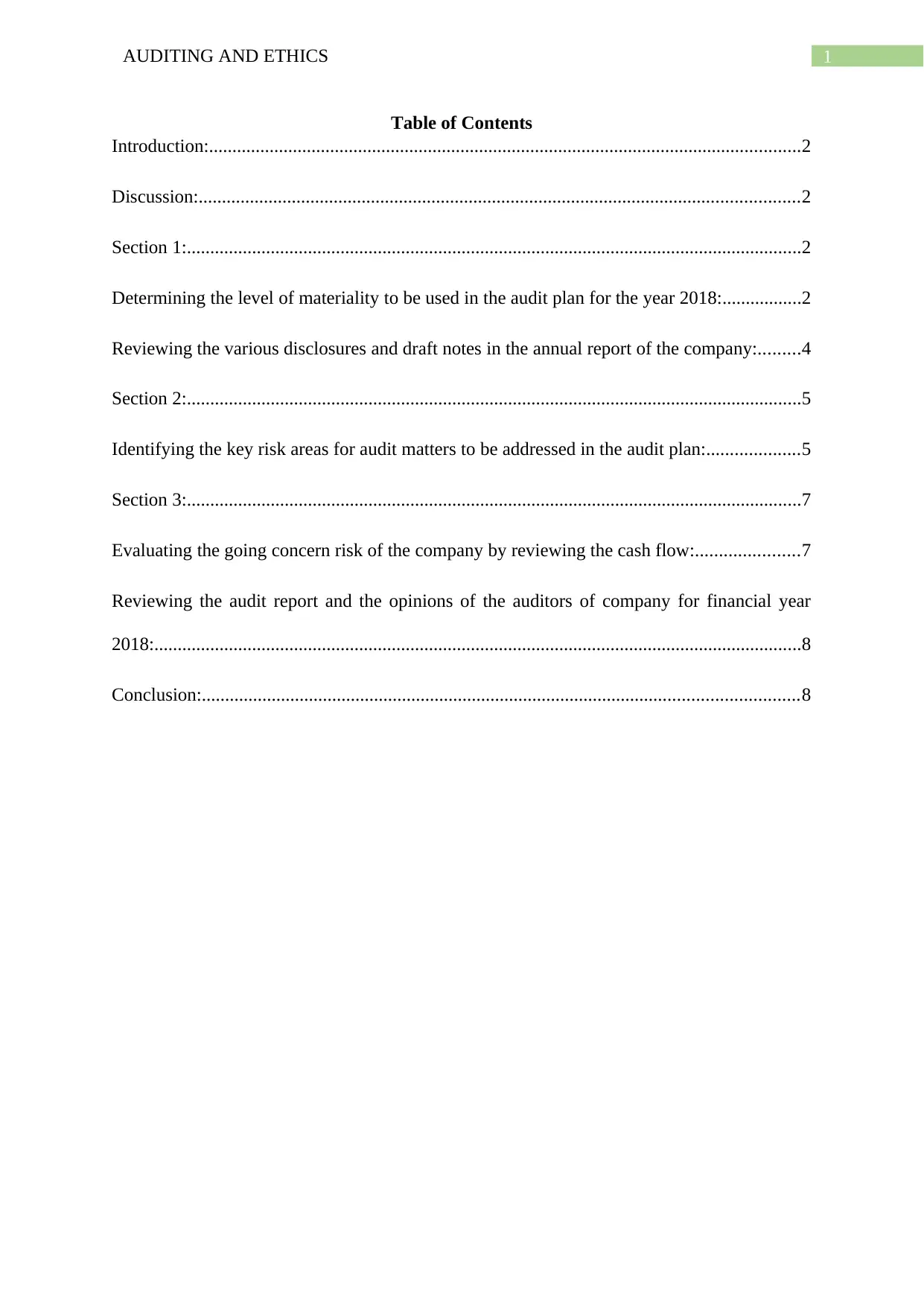
1AUDITING AND ETHICS
Table of Contents
Introduction:...............................................................................................................................2
Discussion:.................................................................................................................................2
Section 1:....................................................................................................................................2
Determining the level of materiality to be used in the audit plan for the year 2018:.................2
Reviewing the various disclosures and draft notes in the annual report of the company:.........4
Section 2:....................................................................................................................................5
Identifying the key risk areas for audit matters to be addressed in the audit plan:....................5
Section 3:....................................................................................................................................7
Evaluating the going concern risk of the company by reviewing the cash flow:......................7
Reviewing the audit report and the opinions of the auditors of company for financial year
2018:...........................................................................................................................................8
Conclusion:................................................................................................................................8
Table of Contents
Introduction:...............................................................................................................................2
Discussion:.................................................................................................................................2
Section 1:....................................................................................................................................2
Determining the level of materiality to be used in the audit plan for the year 2018:.................2
Reviewing the various disclosures and draft notes in the annual report of the company:.........4
Section 2:....................................................................................................................................5
Identifying the key risk areas for audit matters to be addressed in the audit plan:....................5
Section 3:....................................................................................................................................7
Evaluating the going concern risk of the company by reviewing the cash flow:......................7
Reviewing the audit report and the opinions of the auditors of company for financial year
2018:...........................................................................................................................................8
Conclusion:................................................................................................................................8
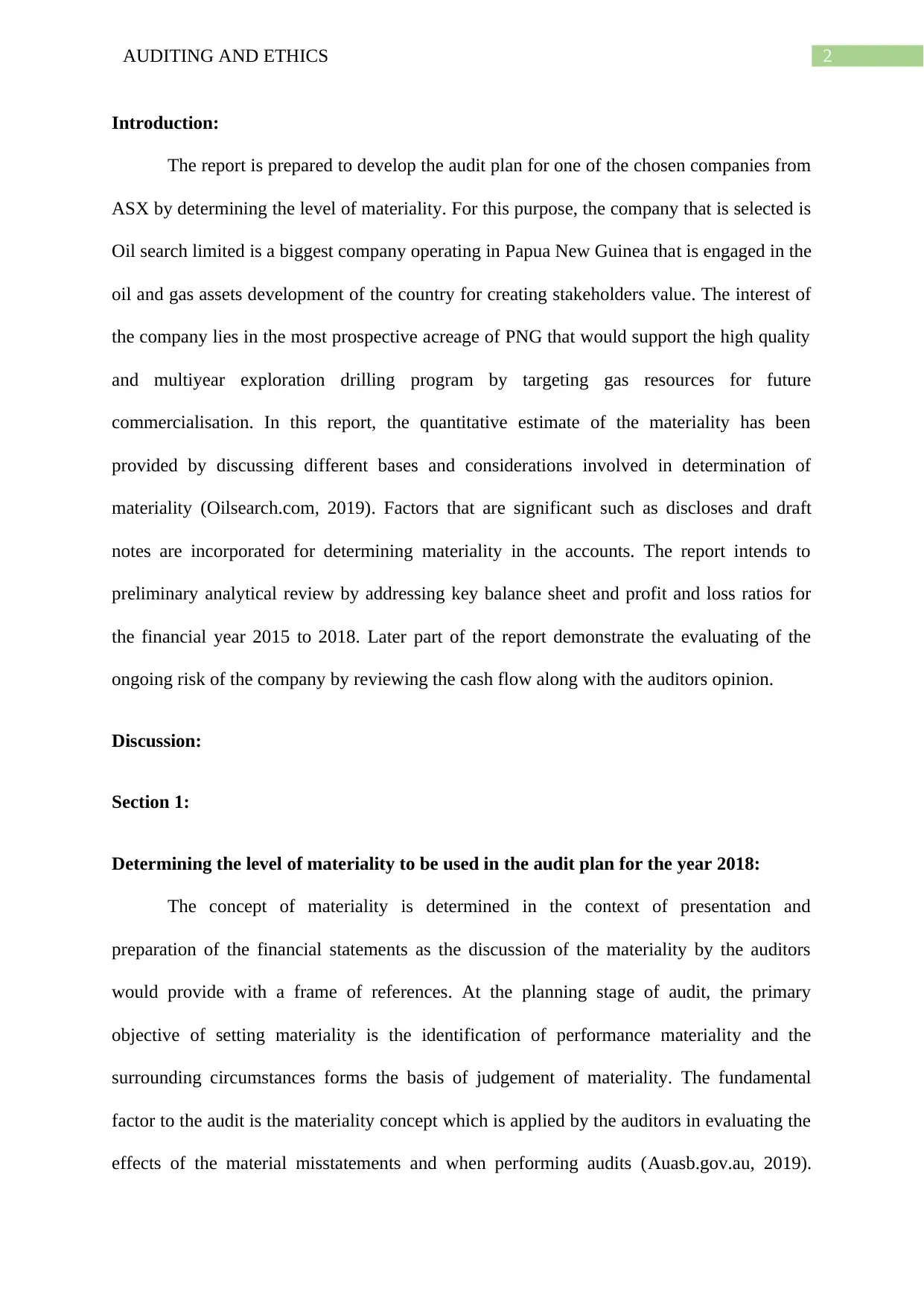
2AUDITING AND ETHICS
Introduction:
The report is prepared to develop the audit plan for one of the chosen companies from
ASX by determining the level of materiality. For this purpose, the company that is selected is
Oil search limited is a biggest company operating in Papua New Guinea that is engaged in the
oil and gas assets development of the country for creating stakeholders value. The interest of
the company lies in the most prospective acreage of PNG that would support the high quality
and multiyear exploration drilling program by targeting gas resources for future
commercialisation. In this report, the quantitative estimate of the materiality has been
provided by discussing different bases and considerations involved in determination of
materiality (Oilsearch.com, 2019). Factors that are significant such as discloses and draft
notes are incorporated for determining materiality in the accounts. The report intends to
preliminary analytical review by addressing key balance sheet and profit and loss ratios for
the financial year 2015 to 2018. Later part of the report demonstrate the evaluating of the
ongoing risk of the company by reviewing the cash flow along with the auditors opinion.
Discussion:
Section 1:
Determining the level of materiality to be used in the audit plan for the year 2018:
The concept of materiality is determined in the context of presentation and
preparation of the financial statements as the discussion of the materiality by the auditors
would provide with a frame of references. At the planning stage of audit, the primary
objective of setting materiality is the identification of performance materiality and the
surrounding circumstances forms the basis of judgement of materiality. The fundamental
factor to the audit is the materiality concept which is applied by the auditors in evaluating the
effects of the material misstatements and when performing audits (Auasb.gov.au, 2019).
Introduction:
The report is prepared to develop the audit plan for one of the chosen companies from
ASX by determining the level of materiality. For this purpose, the company that is selected is
Oil search limited is a biggest company operating in Papua New Guinea that is engaged in the
oil and gas assets development of the country for creating stakeholders value. The interest of
the company lies in the most prospective acreage of PNG that would support the high quality
and multiyear exploration drilling program by targeting gas resources for future
commercialisation. In this report, the quantitative estimate of the materiality has been
provided by discussing different bases and considerations involved in determination of
materiality (Oilsearch.com, 2019). Factors that are significant such as discloses and draft
notes are incorporated for determining materiality in the accounts. The report intends to
preliminary analytical review by addressing key balance sheet and profit and loss ratios for
the financial year 2015 to 2018. Later part of the report demonstrate the evaluating of the
ongoing risk of the company by reviewing the cash flow along with the auditors opinion.
Discussion:
Section 1:
Determining the level of materiality to be used in the audit plan for the year 2018:
The concept of materiality is determined in the context of presentation and
preparation of the financial statements as the discussion of the materiality by the auditors
would provide with a frame of references. At the planning stage of audit, the primary
objective of setting materiality is the identification of performance materiality and the
surrounding circumstances forms the basis of judgement of materiality. The fundamental
factor to the audit is the materiality concept which is applied by the auditors in evaluating the
effects of the material misstatements and when performing audits (Auasb.gov.au, 2019).
⊘ This is a preview!⊘
Do you want full access?
Subscribe today to unlock all pages.

Trusted by 1+ million students worldwide
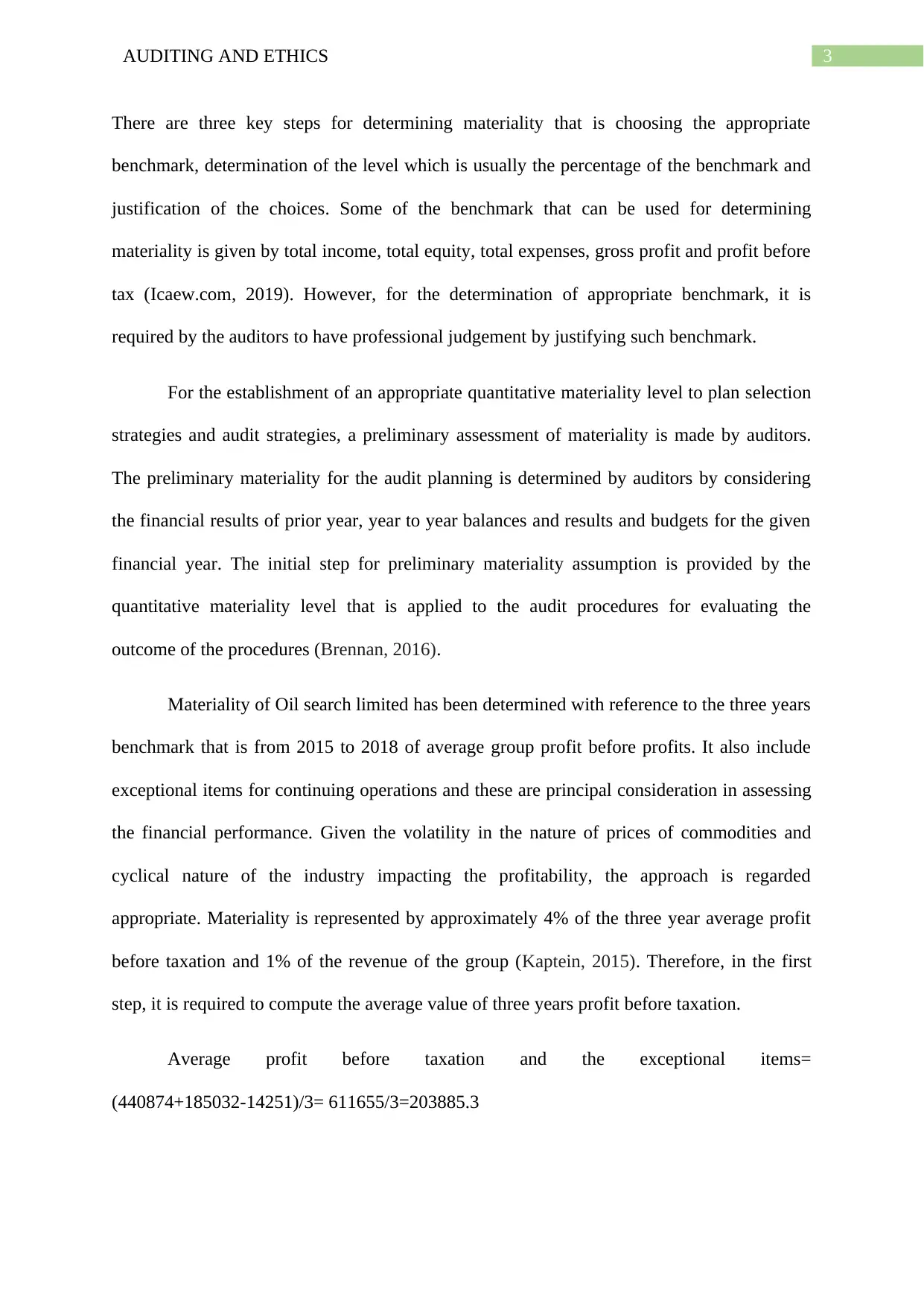
3AUDITING AND ETHICS
There are three key steps for determining materiality that is choosing the appropriate
benchmark, determination of the level which is usually the percentage of the benchmark and
justification of the choices. Some of the benchmark that can be used for determining
materiality is given by total income, total equity, total expenses, gross profit and profit before
tax (Icaew.com, 2019). However, for the determination of appropriate benchmark, it is
required by the auditors to have professional judgement by justifying such benchmark.
For the establishment of an appropriate quantitative materiality level to plan selection
strategies and audit strategies, a preliminary assessment of materiality is made by auditors.
The preliminary materiality for the audit planning is determined by auditors by considering
the financial results of prior year, year to year balances and results and budgets for the given
financial year. The initial step for preliminary materiality assumption is provided by the
quantitative materiality level that is applied to the audit procedures for evaluating the
outcome of the procedures (Brennan, 2016).
Materiality of Oil search limited has been determined with reference to the three years
benchmark that is from 2015 to 2018 of average group profit before profits. It also include
exceptional items for continuing operations and these are principal consideration in assessing
the financial performance. Given the volatility in the nature of prices of commodities and
cyclical nature of the industry impacting the profitability, the approach is regarded
appropriate. Materiality is represented by approximately 4% of the three year average profit
before taxation and 1% of the revenue of the group (Kaptein, 2015). Therefore, in the first
step, it is required to compute the average value of three years profit before taxation.
Average profit before taxation and the exceptional items=
(440874+185032-14251)/3= 611655/3=203885.3
There are three key steps for determining materiality that is choosing the appropriate
benchmark, determination of the level which is usually the percentage of the benchmark and
justification of the choices. Some of the benchmark that can be used for determining
materiality is given by total income, total equity, total expenses, gross profit and profit before
tax (Icaew.com, 2019). However, for the determination of appropriate benchmark, it is
required by the auditors to have professional judgement by justifying such benchmark.
For the establishment of an appropriate quantitative materiality level to plan selection
strategies and audit strategies, a preliminary assessment of materiality is made by auditors.
The preliminary materiality for the audit planning is determined by auditors by considering
the financial results of prior year, year to year balances and results and budgets for the given
financial year. The initial step for preliminary materiality assumption is provided by the
quantitative materiality level that is applied to the audit procedures for evaluating the
outcome of the procedures (Brennan, 2016).
Materiality of Oil search limited has been determined with reference to the three years
benchmark that is from 2015 to 2018 of average group profit before profits. It also include
exceptional items for continuing operations and these are principal consideration in assessing
the financial performance. Given the volatility in the nature of prices of commodities and
cyclical nature of the industry impacting the profitability, the approach is regarded
appropriate. Materiality is represented by approximately 4% of the three year average profit
before taxation and 1% of the revenue of the group (Kaptein, 2015). Therefore, in the first
step, it is required to compute the average value of three years profit before taxation.
Average profit before taxation and the exceptional items=
(440874+185032-14251)/3= 611655/3=203885.3
Paraphrase This Document
Need a fresh take? Get an instant paraphrase of this document with our AI Paraphraser
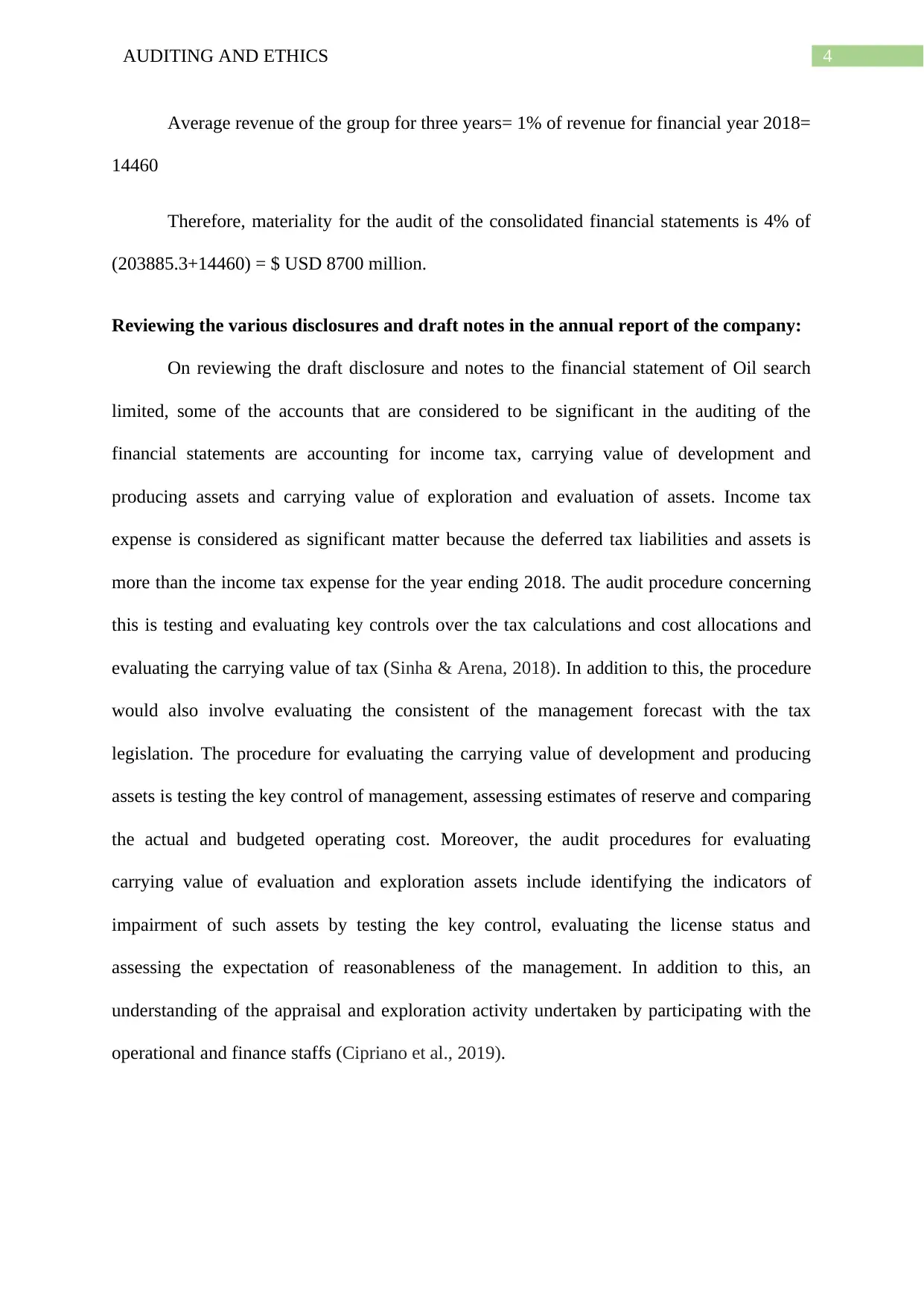
4AUDITING AND ETHICS
Average revenue of the group for three years= 1% of revenue for financial year 2018=
14460
Therefore, materiality for the audit of the consolidated financial statements is 4% of
(203885.3+14460) = $ USD 8700 million.
Reviewing the various disclosures and draft notes in the annual report of the company:
On reviewing the draft disclosure and notes to the financial statement of Oil search
limited, some of the accounts that are considered to be significant in the auditing of the
financial statements are accounting for income tax, carrying value of development and
producing assets and carrying value of exploration and evaluation of assets. Income tax
expense is considered as significant matter because the deferred tax liabilities and assets is
more than the income tax expense for the year ending 2018. The audit procedure concerning
this is testing and evaluating key controls over the tax calculations and cost allocations and
evaluating the carrying value of tax (Sinha & Arena, 2018). In addition to this, the procedure
would also involve evaluating the consistent of the management forecast with the tax
legislation. The procedure for evaluating the carrying value of development and producing
assets is testing the key control of management, assessing estimates of reserve and comparing
the actual and budgeted operating cost. Moreover, the audit procedures for evaluating
carrying value of evaluation and exploration assets include identifying the indicators of
impairment of such assets by testing the key control, evaluating the license status and
assessing the expectation of reasonableness of the management. In addition to this, an
understanding of the appraisal and exploration activity undertaken by participating with the
operational and finance staffs (Cipriano et al., 2019).
Average revenue of the group for three years= 1% of revenue for financial year 2018=
14460
Therefore, materiality for the audit of the consolidated financial statements is 4% of
(203885.3+14460) = $ USD 8700 million.
Reviewing the various disclosures and draft notes in the annual report of the company:
On reviewing the draft disclosure and notes to the financial statement of Oil search
limited, some of the accounts that are considered to be significant in the auditing of the
financial statements are accounting for income tax, carrying value of development and
producing assets and carrying value of exploration and evaluation of assets. Income tax
expense is considered as significant matter because the deferred tax liabilities and assets is
more than the income tax expense for the year ending 2018. The audit procedure concerning
this is testing and evaluating key controls over the tax calculations and cost allocations and
evaluating the carrying value of tax (Sinha & Arena, 2018). In addition to this, the procedure
would also involve evaluating the consistent of the management forecast with the tax
legislation. The procedure for evaluating the carrying value of development and producing
assets is testing the key control of management, assessing estimates of reserve and comparing
the actual and budgeted operating cost. Moreover, the audit procedures for evaluating
carrying value of evaluation and exploration assets include identifying the indicators of
impairment of such assets by testing the key control, evaluating the license status and
assessing the expectation of reasonableness of the management. In addition to this, an
understanding of the appraisal and exploration activity undertaken by participating with the
operational and finance staffs (Cipriano et al., 2019).
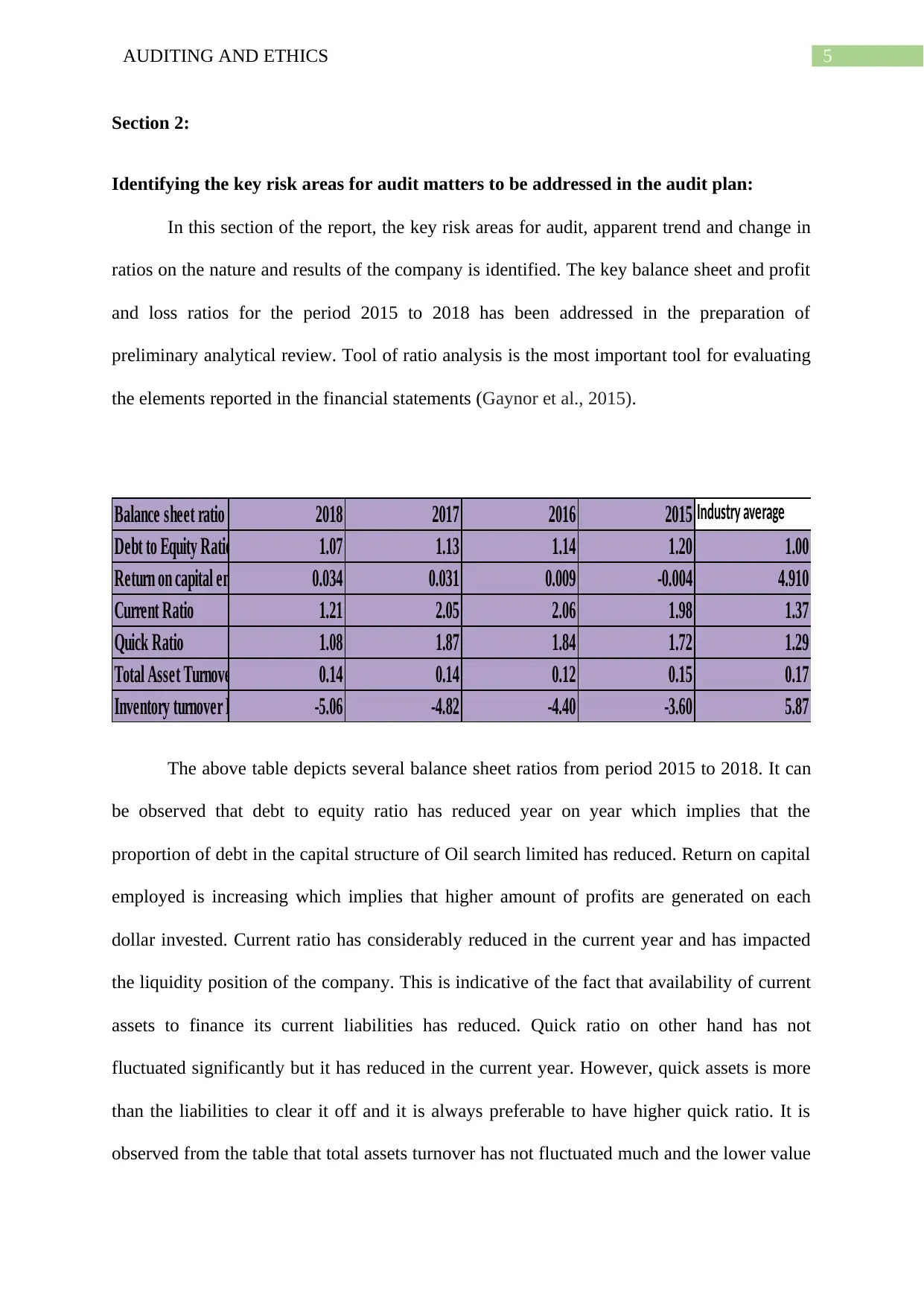
5AUDITING AND ETHICS
Section 2:
Identifying the key risk areas for audit matters to be addressed in the audit plan:
In this section of the report, the key risk areas for audit, apparent trend and change in
ratios on the nature and results of the company is identified. The key balance sheet and profit
and loss ratios for the period 2015 to 2018 has been addressed in the preparation of
preliminary analytical review. Tool of ratio analysis is the most important tool for evaluating
the elements reported in the financial statements (Gaynor et al., 2015).
Balance sheet ratio 2018 2017 2016 2015 Industry average
Debt to Equity Ratio 1.07 1.13 1.14 1.20 1.00
Return on capital employed 0.034 0.031 0.009 -0.004 4.910
Current Ratio 1.21 2.05 2.06 1.98 1.37
Quick Ratio 1.08 1.87 1.84 1.72 1.29
Total Asset Turnover Ratio 0.14 0.14 0.12 0.15 0.17
Inventory turnover Ratio -5.06 -4.82 -4.40 -3.60 5.87
The above table depicts several balance sheet ratios from period 2015 to 2018. It can
be observed that debt to equity ratio has reduced year on year which implies that the
proportion of debt in the capital structure of Oil search limited has reduced. Return on capital
employed is increasing which implies that higher amount of profits are generated on each
dollar invested. Current ratio has considerably reduced in the current year and has impacted
the liquidity position of the company. This is indicative of the fact that availability of current
assets to finance its current liabilities has reduced. Quick ratio on other hand has not
fluctuated significantly but it has reduced in the current year. However, quick assets is more
than the liabilities to clear it off and it is always preferable to have higher quick ratio. It is
observed from the table that total assets turnover has not fluctuated much and the lower value
Section 2:
Identifying the key risk areas for audit matters to be addressed in the audit plan:
In this section of the report, the key risk areas for audit, apparent trend and change in
ratios on the nature and results of the company is identified. The key balance sheet and profit
and loss ratios for the period 2015 to 2018 has been addressed in the preparation of
preliminary analytical review. Tool of ratio analysis is the most important tool for evaluating
the elements reported in the financial statements (Gaynor et al., 2015).
Balance sheet ratio 2018 2017 2016 2015 Industry average
Debt to Equity Ratio 1.07 1.13 1.14 1.20 1.00
Return on capital employed 0.034 0.031 0.009 -0.004 4.910
Current Ratio 1.21 2.05 2.06 1.98 1.37
Quick Ratio 1.08 1.87 1.84 1.72 1.29
Total Asset Turnover Ratio 0.14 0.14 0.12 0.15 0.17
Inventory turnover Ratio -5.06 -4.82 -4.40 -3.60 5.87
The above table depicts several balance sheet ratios from period 2015 to 2018. It can
be observed that debt to equity ratio has reduced year on year which implies that the
proportion of debt in the capital structure of Oil search limited has reduced. Return on capital
employed is increasing which implies that higher amount of profits are generated on each
dollar invested. Current ratio has considerably reduced in the current year and has impacted
the liquidity position of the company. This is indicative of the fact that availability of current
assets to finance its current liabilities has reduced. Quick ratio on other hand has not
fluctuated significantly but it has reduced in the current year. However, quick assets is more
than the liabilities to clear it off and it is always preferable to have higher quick ratio. It is
observed from the table that total assets turnover has not fluctuated much and the lower value
⊘ This is a preview!⊘
Do you want full access?
Subscribe today to unlock all pages.

Trusted by 1+ million students worldwide
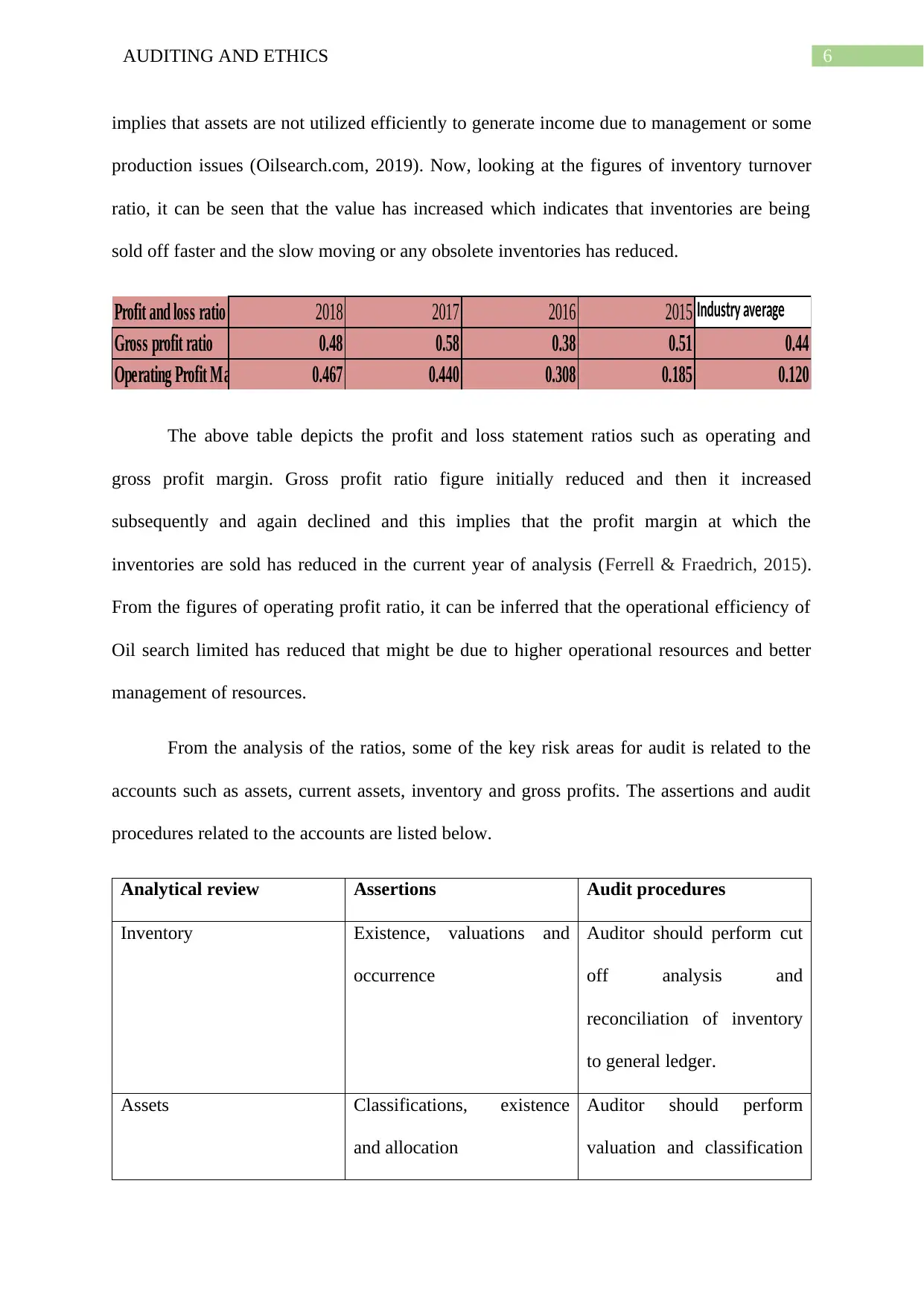
6AUDITING AND ETHICS
implies that assets are not utilized efficiently to generate income due to management or some
production issues (Oilsearch.com, 2019). Now, looking at the figures of inventory turnover
ratio, it can be seen that the value has increased which indicates that inventories are being
sold off faster and the slow moving or any obsolete inventories has reduced.
Profit and loss ratio 2018 2017 2016 2015 Industry average
Gross profit ratio 0.48 0.58 0.38 0.51 0.44
Operating Profit Margin 0.467 0.440 0.308 0.185 0.120
The above table depicts the profit and loss statement ratios such as operating and
gross profit margin. Gross profit ratio figure initially reduced and then it increased
subsequently and again declined and this implies that the profit margin at which the
inventories are sold has reduced in the current year of analysis (Ferrell & Fraedrich, 2015).
From the figures of operating profit ratio, it can be inferred that the operational efficiency of
Oil search limited has reduced that might be due to higher operational resources and better
management of resources.
From the analysis of the ratios, some of the key risk areas for audit is related to the
accounts such as assets, current assets, inventory and gross profits. The assertions and audit
procedures related to the accounts are listed below.
Analytical review Assertions Audit procedures
Inventory Existence, valuations and
occurrence
Auditor should perform cut
off analysis and
reconciliation of inventory
to general ledger.
Assets Classifications, existence
and allocation
Auditor should perform
valuation and classification
implies that assets are not utilized efficiently to generate income due to management or some
production issues (Oilsearch.com, 2019). Now, looking at the figures of inventory turnover
ratio, it can be seen that the value has increased which indicates that inventories are being
sold off faster and the slow moving or any obsolete inventories has reduced.
Profit and loss ratio 2018 2017 2016 2015 Industry average
Gross profit ratio 0.48 0.58 0.38 0.51 0.44
Operating Profit Margin 0.467 0.440 0.308 0.185 0.120
The above table depicts the profit and loss statement ratios such as operating and
gross profit margin. Gross profit ratio figure initially reduced and then it increased
subsequently and again declined and this implies that the profit margin at which the
inventories are sold has reduced in the current year of analysis (Ferrell & Fraedrich, 2015).
From the figures of operating profit ratio, it can be inferred that the operational efficiency of
Oil search limited has reduced that might be due to higher operational resources and better
management of resources.
From the analysis of the ratios, some of the key risk areas for audit is related to the
accounts such as assets, current assets, inventory and gross profits. The assertions and audit
procedures related to the accounts are listed below.
Analytical review Assertions Audit procedures
Inventory Existence, valuations and
occurrence
Auditor should perform cut
off analysis and
reconciliation of inventory
to general ledger.
Assets Classifications, existence
and allocation
Auditor should perform
valuation and classification
Paraphrase This Document
Need a fresh take? Get an instant paraphrase of this document with our AI Paraphraser
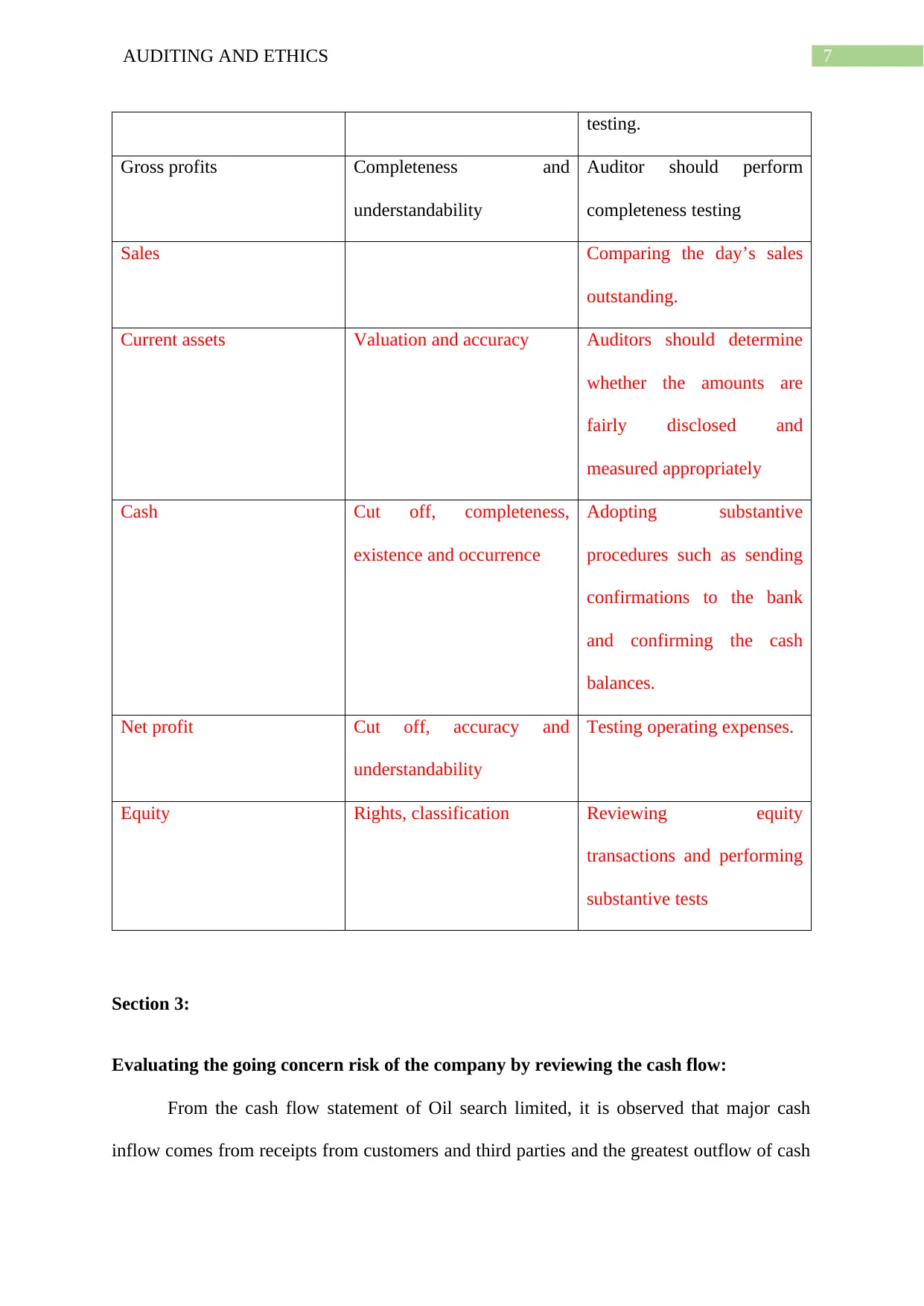
7AUDITING AND ETHICS
testing.
Gross profits Completeness and
understandability
Auditor should perform
completeness testing
Sales Comparing the day’s sales
outstanding.
Current assets Valuation and accuracy Auditors should determine
whether the amounts are
fairly disclosed and
measured appropriately
Cash Cut off, completeness,
existence and occurrence
Adopting substantive
procedures such as sending
confirmations to the bank
and confirming the cash
balances.
Net profit Cut off, accuracy and
understandability
Testing operating expenses.
Equity Rights, classification Reviewing equity
transactions and performing
substantive tests
Section 3:
Evaluating the going concern risk of the company by reviewing the cash flow:
From the cash flow statement of Oil search limited, it is observed that major cash
inflow comes from receipts from customers and third parties and the greatest outflow of cash
testing.
Gross profits Completeness and
understandability
Auditor should perform
completeness testing
Sales Comparing the day’s sales
outstanding.
Current assets Valuation and accuracy Auditors should determine
whether the amounts are
fairly disclosed and
measured appropriately
Cash Cut off, completeness,
existence and occurrence
Adopting substantive
procedures such as sending
confirmations to the bank
and confirming the cash
balances.
Net profit Cut off, accuracy and
understandability
Testing operating expenses.
Equity Rights, classification Reviewing equity
transactions and performing
substantive tests
Section 3:
Evaluating the going concern risk of the company by reviewing the cash flow:
From the cash flow statement of Oil search limited, it is observed that major cash
inflow comes from receipts from customers and third parties and the greatest outflow of cash
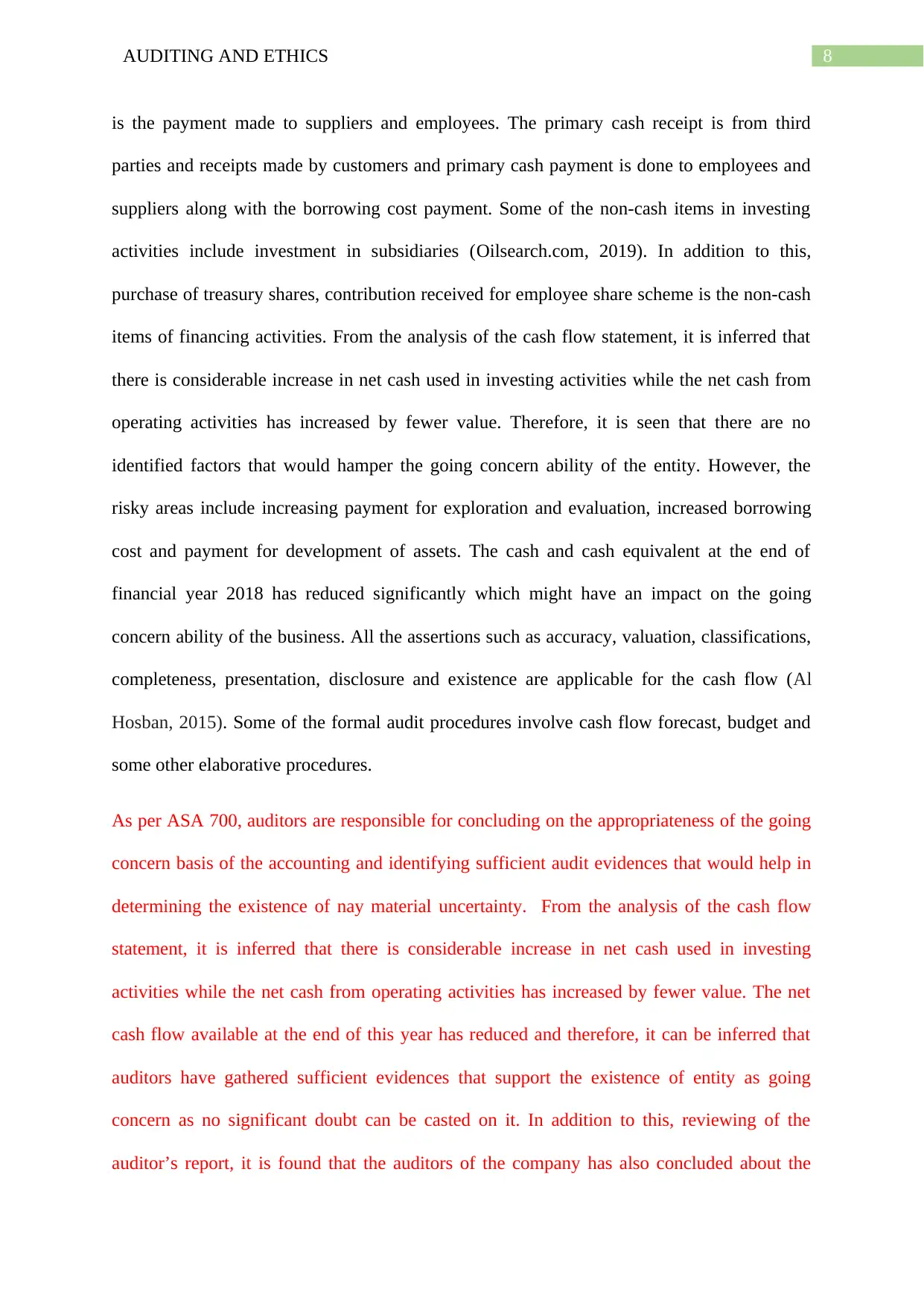
8AUDITING AND ETHICS
is the payment made to suppliers and employees. The primary cash receipt is from third
parties and receipts made by customers and primary cash payment is done to employees and
suppliers along with the borrowing cost payment. Some of the non-cash items in investing
activities include investment in subsidiaries (Oilsearch.com, 2019). In addition to this,
purchase of treasury shares, contribution received for employee share scheme is the non-cash
items of financing activities. From the analysis of the cash flow statement, it is inferred that
there is considerable increase in net cash used in investing activities while the net cash from
operating activities has increased by fewer value. Therefore, it is seen that there are no
identified factors that would hamper the going concern ability of the entity. However, the
risky areas include increasing payment for exploration and evaluation, increased borrowing
cost and payment for development of assets. The cash and cash equivalent at the end of
financial year 2018 has reduced significantly which might have an impact on the going
concern ability of the business. All the assertions such as accuracy, valuation, classifications,
completeness, presentation, disclosure and existence are applicable for the cash flow (Al
Hosban, 2015). Some of the formal audit procedures involve cash flow forecast, budget and
some other elaborative procedures.
As per ASA 700, auditors are responsible for concluding on the appropriateness of the going
concern basis of the accounting and identifying sufficient audit evidences that would help in
determining the existence of nay material uncertainty. From the analysis of the cash flow
statement, it is inferred that there is considerable increase in net cash used in investing
activities while the net cash from operating activities has increased by fewer value. The net
cash flow available at the end of this year has reduced and therefore, it can be inferred that
auditors have gathered sufficient evidences that support the existence of entity as going
concern as no significant doubt can be casted on it. In addition to this, reviewing of the
auditor’s report, it is found that the auditors of the company has also concluded about the
is the payment made to suppliers and employees. The primary cash receipt is from third
parties and receipts made by customers and primary cash payment is done to employees and
suppliers along with the borrowing cost payment. Some of the non-cash items in investing
activities include investment in subsidiaries (Oilsearch.com, 2019). In addition to this,
purchase of treasury shares, contribution received for employee share scheme is the non-cash
items of financing activities. From the analysis of the cash flow statement, it is inferred that
there is considerable increase in net cash used in investing activities while the net cash from
operating activities has increased by fewer value. Therefore, it is seen that there are no
identified factors that would hamper the going concern ability of the entity. However, the
risky areas include increasing payment for exploration and evaluation, increased borrowing
cost and payment for development of assets. The cash and cash equivalent at the end of
financial year 2018 has reduced significantly which might have an impact on the going
concern ability of the business. All the assertions such as accuracy, valuation, classifications,
completeness, presentation, disclosure and existence are applicable for the cash flow (Al
Hosban, 2015). Some of the formal audit procedures involve cash flow forecast, budget and
some other elaborative procedures.
As per ASA 700, auditors are responsible for concluding on the appropriateness of the going
concern basis of the accounting and identifying sufficient audit evidences that would help in
determining the existence of nay material uncertainty. From the analysis of the cash flow
statement, it is inferred that there is considerable increase in net cash used in investing
activities while the net cash from operating activities has increased by fewer value. The net
cash flow available at the end of this year has reduced and therefore, it can be inferred that
auditors have gathered sufficient evidences that support the existence of entity as going
concern as no significant doubt can be casted on it. In addition to this, reviewing of the
auditor’s report, it is found that the auditors of the company has also concluded about the
⊘ This is a preview!⊘
Do you want full access?
Subscribe today to unlock all pages.

Trusted by 1+ million students worldwide
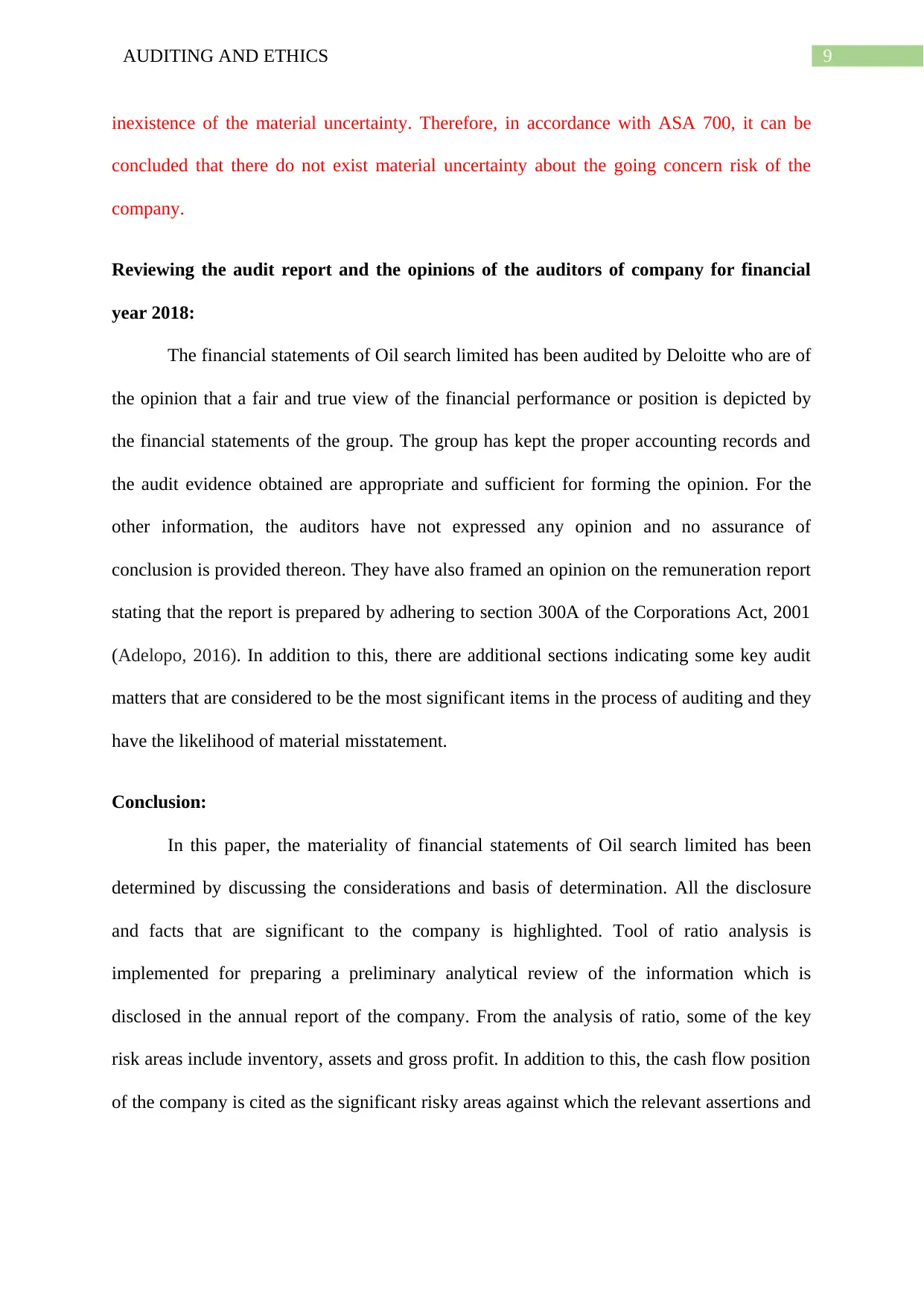
9AUDITING AND ETHICS
inexistence of the material uncertainty. Therefore, in accordance with ASA 700, it can be
concluded that there do not exist material uncertainty about the going concern risk of the
company.
Reviewing the audit report and the opinions of the auditors of company for financial
year 2018:
The financial statements of Oil search limited has been audited by Deloitte who are of
the opinion that a fair and true view of the financial performance or position is depicted by
the financial statements of the group. The group has kept the proper accounting records and
the audit evidence obtained are appropriate and sufficient for forming the opinion. For the
other information, the auditors have not expressed any opinion and no assurance of
conclusion is provided thereon. They have also framed an opinion on the remuneration report
stating that the report is prepared by adhering to section 300A of the Corporations Act, 2001
(Adelopo, 2016). In addition to this, there are additional sections indicating some key audit
matters that are considered to be the most significant items in the process of auditing and they
have the likelihood of material misstatement.
Conclusion:
In this paper, the materiality of financial statements of Oil search limited has been
determined by discussing the considerations and basis of determination. All the disclosure
and facts that are significant to the company is highlighted. Tool of ratio analysis is
implemented for preparing a preliminary analytical review of the information which is
disclosed in the annual report of the company. From the analysis of ratio, some of the key
risk areas include inventory, assets and gross profit. In addition to this, the cash flow position
of the company is cited as the significant risky areas against which the relevant assertions and
inexistence of the material uncertainty. Therefore, in accordance with ASA 700, it can be
concluded that there do not exist material uncertainty about the going concern risk of the
company.
Reviewing the audit report and the opinions of the auditors of company for financial
year 2018:
The financial statements of Oil search limited has been audited by Deloitte who are of
the opinion that a fair and true view of the financial performance or position is depicted by
the financial statements of the group. The group has kept the proper accounting records and
the audit evidence obtained are appropriate and sufficient for forming the opinion. For the
other information, the auditors have not expressed any opinion and no assurance of
conclusion is provided thereon. They have also framed an opinion on the remuneration report
stating that the report is prepared by adhering to section 300A of the Corporations Act, 2001
(Adelopo, 2016). In addition to this, there are additional sections indicating some key audit
matters that are considered to be the most significant items in the process of auditing and they
have the likelihood of material misstatement.
Conclusion:
In this paper, the materiality of financial statements of Oil search limited has been
determined by discussing the considerations and basis of determination. All the disclosure
and facts that are significant to the company is highlighted. Tool of ratio analysis is
implemented for preparing a preliminary analytical review of the information which is
disclosed in the annual report of the company. From the analysis of ratio, some of the key
risk areas include inventory, assets and gross profit. In addition to this, the cash flow position
of the company is cited as the significant risky areas against which the relevant assertions and
Paraphrase This Document
Need a fresh take? Get an instant paraphrase of this document with our AI Paraphraser
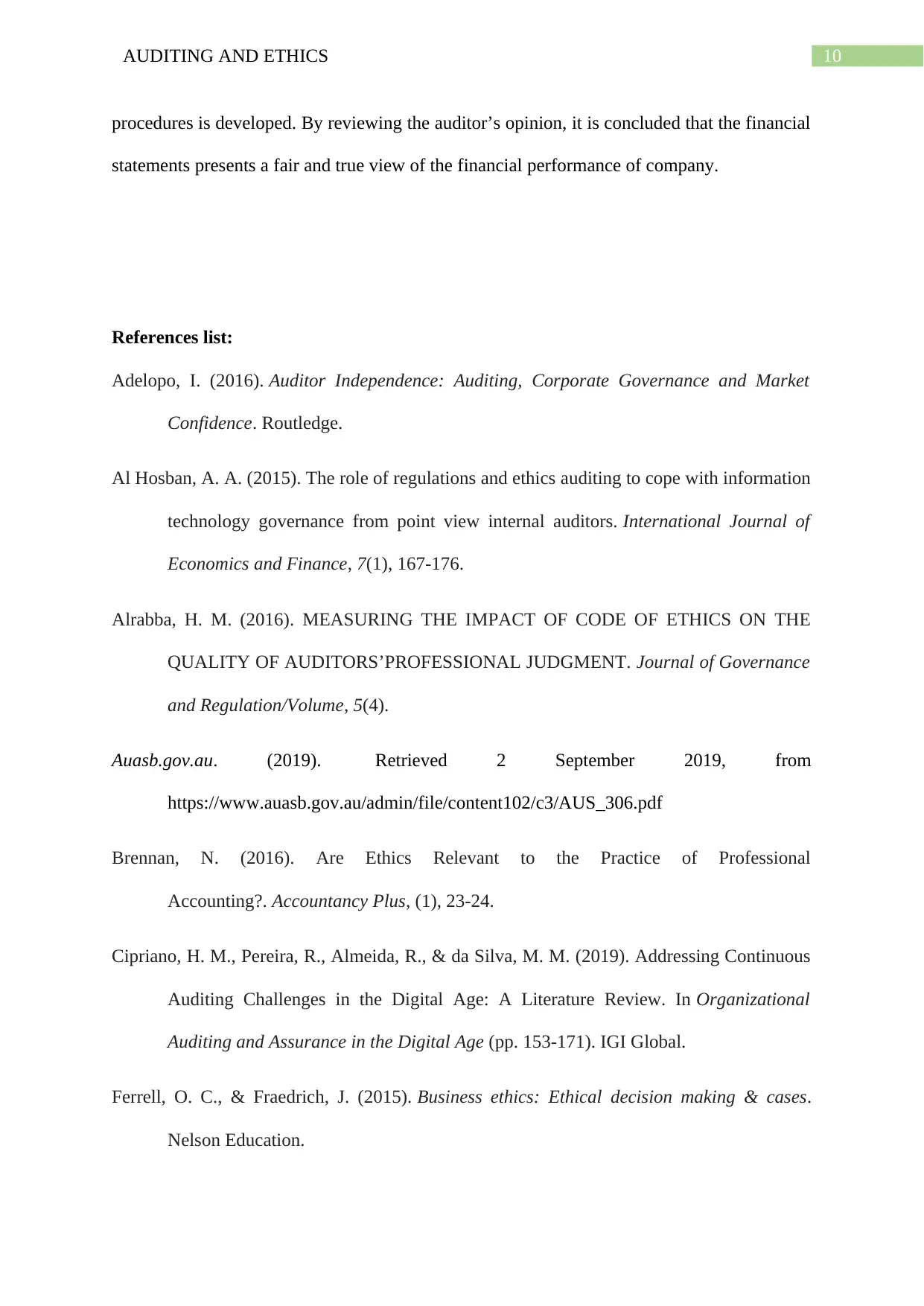
10AUDITING AND ETHICS
procedures is developed. By reviewing the auditor’s opinion, it is concluded that the financial
statements presents a fair and true view of the financial performance of company.
References list:
Adelopo, I. (2016). Auditor Independence: Auditing, Corporate Governance and Market
Confidence. Routledge.
Al Hosban, A. A. (2015). The role of regulations and ethics auditing to cope with information
technology governance from point view internal auditors. International Journal of
Economics and Finance, 7(1), 167-176.
Alrabba, H. M. (2016). MEASURING THE IMPACT OF CODE OF ETHICS ON THE
QUALITY OF AUDITORS’PROFESSIONAL JUDGMENT. Journal of Governance
and Regulation/Volume, 5(4).
Auasb.gov.au. (2019). Retrieved 2 September 2019, from
https://www.auasb.gov.au/admin/file/content102/c3/AUS_306.pdf
Brennan, N. (2016). Are Ethics Relevant to the Practice of Professional
Accounting?. Accountancy Plus, (1), 23-24.
Cipriano, H. M., Pereira, R., Almeida, R., & da Silva, M. M. (2019). Addressing Continuous
Auditing Challenges in the Digital Age: A Literature Review. In Organizational
Auditing and Assurance in the Digital Age (pp. 153-171). IGI Global.
Ferrell, O. C., & Fraedrich, J. (2015). Business ethics: Ethical decision making & cases.
Nelson Education.
procedures is developed. By reviewing the auditor’s opinion, it is concluded that the financial
statements presents a fair and true view of the financial performance of company.
References list:
Adelopo, I. (2016). Auditor Independence: Auditing, Corporate Governance and Market
Confidence. Routledge.
Al Hosban, A. A. (2015). The role of regulations and ethics auditing to cope with information
technology governance from point view internal auditors. International Journal of
Economics and Finance, 7(1), 167-176.
Alrabba, H. M. (2016). MEASURING THE IMPACT OF CODE OF ETHICS ON THE
QUALITY OF AUDITORS’PROFESSIONAL JUDGMENT. Journal of Governance
and Regulation/Volume, 5(4).
Auasb.gov.au. (2019). Retrieved 2 September 2019, from
https://www.auasb.gov.au/admin/file/content102/c3/AUS_306.pdf
Brennan, N. (2016). Are Ethics Relevant to the Practice of Professional
Accounting?. Accountancy Plus, (1), 23-24.
Cipriano, H. M., Pereira, R., Almeida, R., & da Silva, M. M. (2019). Addressing Continuous
Auditing Challenges in the Digital Age: A Literature Review. In Organizational
Auditing and Assurance in the Digital Age (pp. 153-171). IGI Global.
Ferrell, O. C., & Fraedrich, J. (2015). Business ethics: Ethical decision making & cases.
Nelson Education.
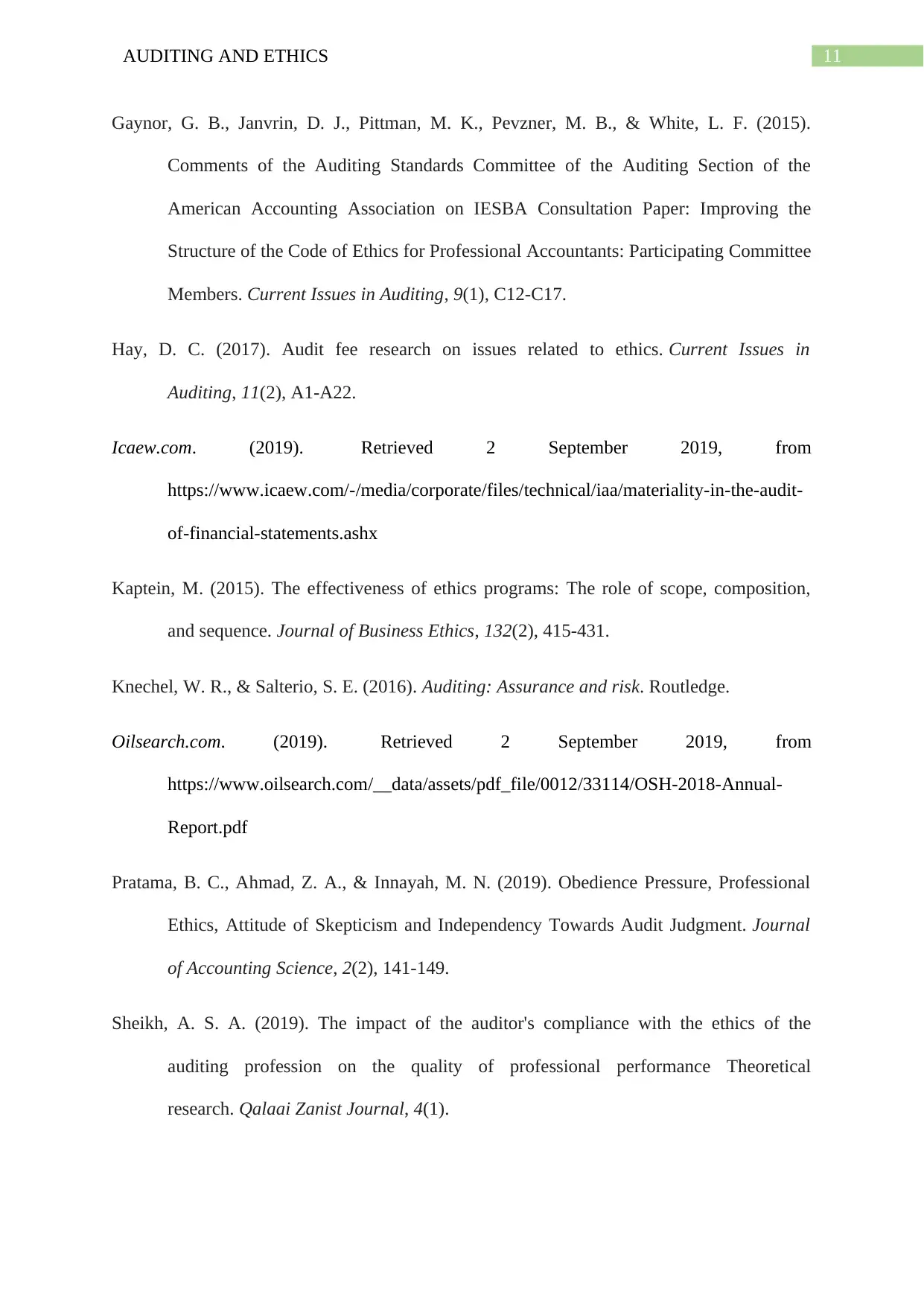
11AUDITING AND ETHICS
Gaynor, G. B., Janvrin, D. J., Pittman, M. K., Pevzner, M. B., & White, L. F. (2015).
Comments of the Auditing Standards Committee of the Auditing Section of the
American Accounting Association on IESBA Consultation Paper: Improving the
Structure of the Code of Ethics for Professional Accountants: Participating Committee
Members. Current Issues in Auditing, 9(1), C12-C17.
Hay, D. C. (2017). Audit fee research on issues related to ethics. Current Issues in
Auditing, 11(2), A1-A22.
Icaew.com. (2019). Retrieved 2 September 2019, from
https://www.icaew.com/-/media/corporate/files/technical/iaa/materiality-in-the-audit-
of-financial-statements.ashx
Kaptein, M. (2015). The effectiveness of ethics programs: The role of scope, composition,
and sequence. Journal of Business Ethics, 132(2), 415-431.
Knechel, W. R., & Salterio, S. E. (2016). Auditing: Assurance and risk. Routledge.
Oilsearch.com. (2019). Retrieved 2 September 2019, from
https://www.oilsearch.com/__data/assets/pdf_file/0012/33114/OSH-2018-Annual-
Report.pdf
Pratama, B. C., Ahmad, Z. A., & Innayah, M. N. (2019). Obedience Pressure, Professional
Ethics, Attitude of Skepticism and Independency Towards Audit Judgment. Journal
of Accounting Science, 2(2), 141-149.
Sheikh, A. S. A. (2019). The impact of the auditor's compliance with the ethics of the
auditing profession on the quality of professional performance Theoretical
research. Qalaai Zanist Journal, 4(1).
Gaynor, G. B., Janvrin, D. J., Pittman, M. K., Pevzner, M. B., & White, L. F. (2015).
Comments of the Auditing Standards Committee of the Auditing Section of the
American Accounting Association on IESBA Consultation Paper: Improving the
Structure of the Code of Ethics for Professional Accountants: Participating Committee
Members. Current Issues in Auditing, 9(1), C12-C17.
Hay, D. C. (2017). Audit fee research on issues related to ethics. Current Issues in
Auditing, 11(2), A1-A22.
Icaew.com. (2019). Retrieved 2 September 2019, from
https://www.icaew.com/-/media/corporate/files/technical/iaa/materiality-in-the-audit-
of-financial-statements.ashx
Kaptein, M. (2015). The effectiveness of ethics programs: The role of scope, composition,
and sequence. Journal of Business Ethics, 132(2), 415-431.
Knechel, W. R., & Salterio, S. E. (2016). Auditing: Assurance and risk. Routledge.
Oilsearch.com. (2019). Retrieved 2 September 2019, from
https://www.oilsearch.com/__data/assets/pdf_file/0012/33114/OSH-2018-Annual-
Report.pdf
Pratama, B. C., Ahmad, Z. A., & Innayah, M. N. (2019). Obedience Pressure, Professional
Ethics, Attitude of Skepticism and Independency Towards Audit Judgment. Journal
of Accounting Science, 2(2), 141-149.
Sheikh, A. S. A. (2019). The impact of the auditor's compliance with the ethics of the
auditing profession on the quality of professional performance Theoretical
research. Qalaai Zanist Journal, 4(1).
⊘ This is a preview!⊘
Do you want full access?
Subscribe today to unlock all pages.

Trusted by 1+ million students worldwide
1 out of 15
Related Documents
Your All-in-One AI-Powered Toolkit for Academic Success.
+13062052269
info@desklib.com
Available 24*7 on WhatsApp / Email
![[object Object]](/_next/static/media/star-bottom.7253800d.svg)
Unlock your academic potential
Copyright © 2020–2025 A2Z Services. All Rights Reserved. Developed and managed by ZUCOL.





